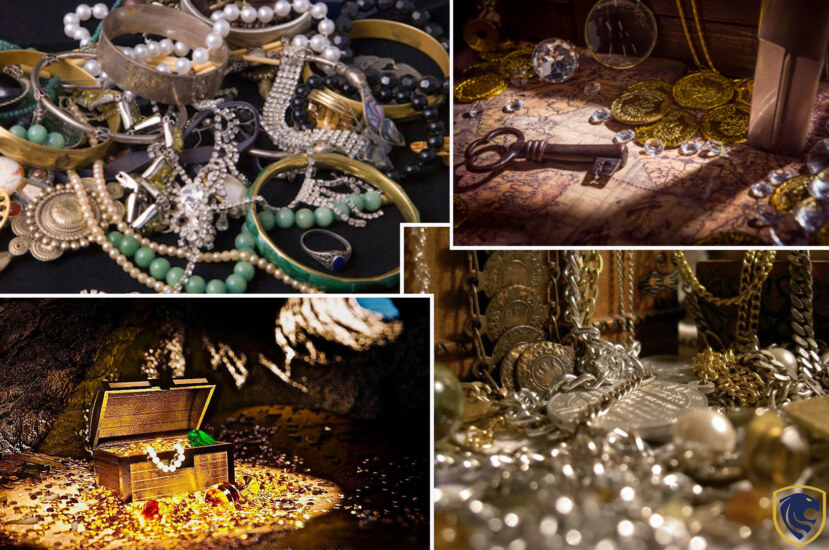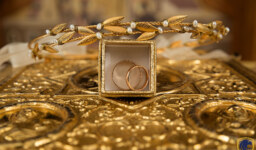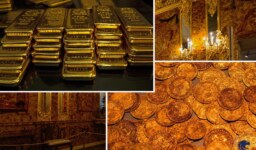The Lufthansa Heist Loot
A criminal family from New York known as the Lucchese clan is believed to have forced break-ins at the Lufthansa terminal at John F. Kennedy Airport to steal. This was on Long Island on December 11th. There were an estimated $5 million in cash and roughly $875,000 in jewels. The robbery was a major plot point in the movie Goodfellas, which properly captured its aftermath. Since then, it has been the subject of several novels, movies, and documentaries. After paying the proper “tribute” to the mob leaders who approved the heist, the robbery’s primary planner, Jimmy Burke, began an effort to kill most of the other participants in the crime. So, that he may keep most of the treasures feasible.

Lost Treasures Around The World; The Lufthansa Heist Loot
Despite several former gang leaders who later turned into government spies making claims about what happened to the cash and jewelry, none of them have been verified. Moreover, no one has ever discovered money. Jimmy Burke kept the place a secret his entire life.
Or if he did, the individual or people who knew the site never reported it to any law enforcement official. Investigators suspected that the money, or at least some of it, was hidden on sites Burke’s team frequently visited in the days following the crime as a result of wiretaps. But, they were unable to compile sufficient evidence to get a search warrant.
Boston College points-shaving scandal
Jimmy Burke was jailed for his part in the Boston College points-shaving scandal. Also because ordering the deaths of almost anybody who may linked him to the Lufthansa theft. He was found guilty of a previous murder while he was incarcerated. Lung cancer took his life in jail. He never disclosed the whereabouts of the money or the diamonds. The tribute was the sole sum of money that is documented to have been given out. One of the heist survivors was seen grumbling on camera during a 2015 trial that no one ever saw any of the money.

Lost Treasures Around The World; Boston College points-shaving scandal
the keys to a safe deposit
A former mafia associate who later turned spy agent stated in 2014 that Burke had given his two daughters the keys to a safe deposit box where part of the money was kept. One daughter was allegedly exploited by the mob to fund a never-produced cartoon film. Once the box was unlocked, it was simple to regularly take large sums of money. The majority of which were lost at gambling casinos. But, law enforcement officials familiar with the investigation and the alleged players claimed that this allegation was completely false.

Lost Treasures Around The World; The Lufthansa Heist Loot
Cash and jewelry worth approximately 6 million dollars, and perhaps, even more, considering the current price of gold and silver, are still out there. Cash and jewelry worth approximately $6 million are still unknown. Also, considering the price of gold and silver now compared to 1978, the amount may be even higher. If anybody does know where it is and that the majority of the crooks involved are deceased, they are not speaking. Despite modifications to the design of American currency, most of the notes would still be considered legal tender today. As some of the money was a tribute and some were surely spent by Jimmy Burke, there is likely a stash of stolen but completely untraceable money totaling more than $4 million somewhere in or around New York or New Jersey.
Eight Fabergé eggs
Maybe the best and most well-known jeweler of all time is Peter Carl Fabergé. A master of his trade, he is considered by many to be one of the very best in his field. At auctions, where the remaining pieces of his work are often offered, they are commonly sold for millions of dollars.
Several of his masterpieces, including possibly his most well-known ones, the Fabergé Imperial eggs, were sold to the Russian Royal bloodline. The Russian Tsars gave their wives these lovely trinkets as Easter presents. And they were manufactured to order.

Lost Treasures Around The World; Eight Fabergé eggs
52 of the 69 eggs Fabergé produced were Imperial eggs. Tsar Alexander III gave his wife the first one in 1885. Then his son and successor Nicholas II gave her the last one in 1917.
If it hadn’t been for the Russian Revolution, the Imperial family would have lived to celebrate another Easter.
These 52 eggs were meticulously created using the highest standards of craftsmanship and materials. They are still well-guarded today. Because they are priceless artifacts from the long-gone Russian imperial world that are also priceless in and of themselves.
Eggs go missing
The earliest lost egg is just the second ever created by Fabergé. The 1886-made “Hen with Sapphire Pendant” egg was last noted in the Kremlin Armory’s inventory in 1922. It disappears after that, Also, it is unknown if it was demolished or is now in private hands. Surprisingly, we don’t even know what it looks like. Because there are no surviving photos that depict the egg or its surprise. The “Cherub with Chariot” egg, which was created in 1888, is the second lost egg. Just a blurry snapshot of this egg has survived. Therefore little else is known about it. The surprise is described, and it looks like the egg has vertical ridges going up its sides.

Lost Treasures Around The World; Eight Fabergé eggs
The surprise is said to be a clock that is allegedly within the egg and is being pulled by a cherub or angel in a chariot. The egg looks to have vertical ridges going along its sides. Before being moved to the Sovnarkom, the highest level executive body of the Russian Communist Party, in 1922, this egg was also housed in the Kremlin’s Armory. It’s unclear where it went from there, although it’s likely still in Russian private hands.
The third missing egg was made by Fabergé a year later, in 1889. And is referred to as the “Nécessaire” egg. We have more information about this egg, so we can piece together what it would have looked like. This was a more practical egg, as indicated by its name. It was a collection of toiletries. Although the egg was merely a simple box for storage, it was lavishly adorned with leaf imprints. It is also said to be coated in sapphires, emeralds, and rubies.
Recent News

Lost Treasures Around The World; Eight Fabergé eggs.
The missing Fabergé eggs had just made the news. A gold object was purchased by a US metal trader in 2014 at a Midwest antique market to melt it down for an arbitrary scrap value. He was startled to discover that it was the 1887 Fabergé Imperial egg, which is estimated to be worth $33 million.
San Miguel de Archangel
Between the New World and Spain, several Spanish treasure ships with the name San Miguel drowned. But, one stands out as being very intriguing. A ship of the 1715 Spanish Treasure fleet named San Miguel de Archangel, also referred to as Saint Michael the Archangel left Havana only in time to be completely destroyed by a hurricane off the coast of Florida. Gold, silver, emeralds, pearls, and other costly gems that the Spanish had taken from the Aztecs were loaded onto the flotilla. That is done in order to bolster the Spanish Empire’s finances. Instead, some of the stolen wealth has continued to wash up on Florida’s treasure coast 300 years later.

Lost Treasures Around The World; San Miguel de Archangel
A sizable section of the Treasure Fleet has been discovered. And it is saved close to Sebastian Inlet, where the hurricane sent the ships to the bottom three centuries ago. The Spanish fleet consisted of a variety of boats. That includes huge galleons, all of which were lost and have since been found, and fewer carracks. A carrack was a lighter boat that was quicker under sail than a galleon. Moreover, it was simpler to control variable winds and heavy seas. Carracks were preferred for transporting goods, including the Aztecs’ valuables. But galleons were thought to be better for the defense of the fleet. During the Spanish Reconquista, San Miguel de Archangel was used as a carrack.
Ships carrying the treasure
The size and make-up of the treasure fleet are known today. Because of the documents the Spaniards preserved at Havana. Ships carrying the treasure taken from Mexico arrived at Havana from Vera Cruz, Cartagena, and Porto Bello. Le Griffon, a French merchant ship, joined to take advantage of the Spanish galleons’ defense against the pirates that prowled the Caribbean in search of the valuables that the Spaniards had taken from what they dubbed New Spain. Together with the French ship, a total of eleven Spanish ships gathered in the harbor of Havana. The Spaniards purposefully delayed their departure until the end of hurricane season due to the fear of pirates, thinking they could avoid Florida’s coast and find safety nearby.

Lost Treasures Around The World; San Miguel de Archangel
After departing Havana, the fleet managed to escape. But the storms claimed the lives of nearly a thousand sailors. The Spaniards used native divers and slaves to recover more than half of the treasures that went down in the various ships since they were aware of exactly where the majority of them went down, and they used these people to recover at least half of the treasures. There has been a great deal of treasure recovered since the late 20th century, which is good news for the country. But bits and pieces of New Spain’s wealth still regularly wash up on Florida’s Treasure Coast. That includes gold necklaces, chalices, and occasionally gold and silver ingots. Except for one, all of the ships in the treasure fleet have been identified and their whereabouts are known.
Miguel de Archangel traveled further to the north
Before losing itself to the sea, it is thought that the carrack San Miguel de Archangel traveled to latitudes further north than the rest of the fleet during the storm. It is hard to determine how much further north it went. But it most likely stayed close to land since the hurricane’s winds would have prevented it from traveling to open water. Off the coast of Florida, the ship that may have been the wealthiest of the whole 1715 treasure fleet remains submerged and waiting to be uncovered and stripped of the gold and silver plate, emeralds, diamonds, and pearls it carried when it sailed from Havana three centuries ago.

Lost Treasures Around The World; Miguel de Archangel traveled further to the north



